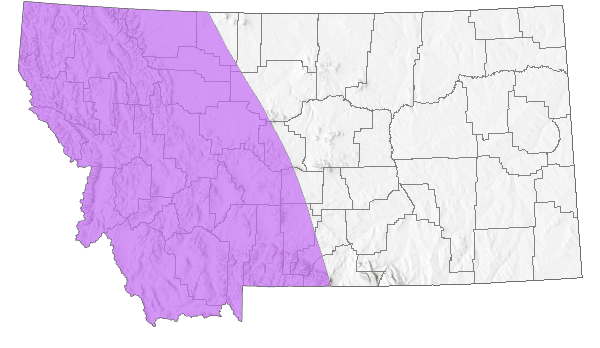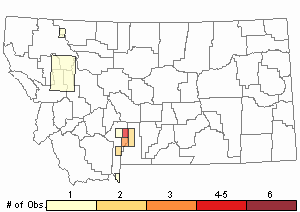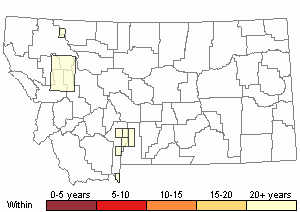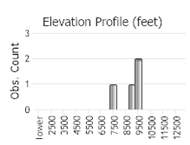View in other NatureServe Network Field Guides
NatureServe
Montana
Utah
Wyoming
Idaho
Wisconsin
British Columbia
South Carolina
Yukon
California
New York
Oregon Short-winged Grasshopper - Melanoplus oregonensis
Other Names:
Oregon Spur-throat Grasshopper
General Description
The following comes from Hebard (1928), Brooks (1958), Vickery and Kevan (1985), and Scott (2010). A small, short-winged mountain grasshopper. Body color dark brown to grayish brown. Outer face of hind femur is yellow ventrally and not banded. The hind tibia can be yellowish-buff or blue.
Phenology
Overwinters in the egg stage. Adults occur from mid-June through August (Vickery and Kevan 1985).
Diagnostic Characteristics
The body length of both males and females range from 18 to 23 mm. The wings (tegmina) are short, reaching to only the second abdominal segment (Hebard 1928, Brooks 1958, Vickery and Kevan 1985, and Scott 2010).
This species can be confused with any of the small, short-winged Melanoplus species. Examination of the male genitalia is required for positive identification. There are three recognized subspecies: M. oregonensis, M. oregonensis triangularis and M. oregonensis ascensor (Brooks 1958).
Species Range
Montana Range
Range Descriptions

 Native
Native
Range Comments
The geographical range of this species is reported by the subspecies’ occurrences as follows: M. oregonensis is found at high elevations in southern Alberta, Idaho, and southwest Montana. M. oregonensis ascensor is known from the high elevations in Wyoming and Colorado. M. oregonensis triangularis occurs in southern Alberta, Idaho, and northwest Montana (Hebard 1928, Brooks 1958, Vickery and Kevan 1985).
Observations in Montana Natural Heritage Program Database
Number of Observations: 17
(Click on the following maps and charts to see full sized version)
Map Help and Descriptions
Relative Density

Recency



 (Observations spanning multiple months or years are excluded from time charts)
(Observations spanning multiple months or years are excluded from time charts)
Habitat
The Oregon Short-winged grasshopper inhabits tall grasses and weedy areas at altitudes from 4900 feet to 8400 feet (Hebard 1928, Vickery and Kevan 1985).
Food Habits
Unknown
Reproductive Characteristics
Unknown
Stewardship Responsibility
References
- Literature Cited AboveLegend:
 View Online Publication
View Online Publication Brooks, A.R. 1958. Acridoidea of Southern Alberta, Saskatchewan, and Manitoba (Orthoptera). The Canadian Entomologist (Supplement 9) 90:5-92.
Brooks, A.R. 1958. Acridoidea of Southern Alberta, Saskatchewan, and Manitoba (Orthoptera). The Canadian Entomologist (Supplement 9) 90:5-92. Hebard, M. 1928. The Orthoptera of Montana. Proceedings of the Academy of Natural Sciences of Philadelphia, Vol. 80:211-306.
Hebard, M. 1928. The Orthoptera of Montana. Proceedings of the Academy of Natural Sciences of Philadelphia, Vol. 80:211-306. Scott, R.D. 2010. Montana Grasshoppers, Katydids, and Crickets A Pictorial Field Guide to the Orthoptera. MagpieMTGraphics, Billings, MT.
Scott, R.D. 2010. Montana Grasshoppers, Katydids, and Crickets A Pictorial Field Guide to the Orthoptera. MagpieMTGraphics, Billings, MT. Vickery, V. R. and D. K. M. Kevan. 1985. The grasshopper, crickets, and related insects of Canada and adjacent regions. Biosystematics Research Institute, Ottawa, Ontario. Publication Number 1777. 918 pp.
Vickery, V. R. and D. K. M. Kevan. 1985. The grasshopper, crickets, and related insects of Canada and adjacent regions. Biosystematics Research Institute, Ottawa, Ontario. Publication Number 1777. 918 pp.
- Additional ReferencesLegend:
 View Online Publication
View Online Publication
Do you know of a citation we're missing? Anderson, N.L. 1962. Grasshopper-vegetation relationships on Montana grasslands. Ph.D Dissertation. Bozeman, Montana: Montana State University. 73 p.
Anderson, N.L. 1962. Grasshopper-vegetation relationships on Montana grasslands. Ph.D Dissertation. Bozeman, Montana: Montana State University. 73 p. Capinera, J.L., R.D. Scott, and T.J. Walker. 2004. Field Guide to Grasshoppers, Katydids, and Crickets of the United States. Ithaca, NY. Cornell University Press.
Capinera, J.L., R.D. Scott, and T.J. Walker. 2004. Field Guide to Grasshoppers, Katydids, and Crickets of the United States. Ithaca, NY. Cornell University Press. Hebard, M. 1932. Notes on Montana Orthoptera. Proceedings of the Academy of Natural Sciences of Philadelphia. V. 84. pp 251-257.
Hebard, M. 1932. Notes on Montana Orthoptera. Proceedings of the Academy of Natural Sciences of Philadelphia. V. 84. pp 251-257. Henry, J.E. 1969. Protozoan and viral pathogens of grasshoppers. Ph.D. Dissertation. Bozeman, MT: Montana State University. 153 p.
Henry, J.E. 1969. Protozoan and viral pathogens of grasshoppers. Ph.D. Dissertation. Bozeman, MT: Montana State University. 153 p. Wachter, D.H. 1995. The ecology of selected grasshopper species along an elevational gradient. M.Sc. Thesis. Bozeman, Montana: Montana State University. 59 p.
Wachter, D.H. 1995. The ecology of selected grasshopper species along an elevational gradient. M.Sc. Thesis. Bozeman, Montana: Montana State University. 59 p.
- Web Search Engines for Articles on "Oregon Short-winged Grasshopper"
- Additional Sources of Information Related to "Insects"





